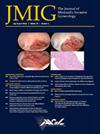Vaginal Bulge is Not Always Prolapse
IF 3.5
2区 医学
Q1 OBSTETRICS & GYNECOLOGY
引用次数: 0
Abstract
Objective
The objective of this video is to review a case of a patient that presented to urogynecology clinic for prolapse but was noted to have anterior vaginal cyst. In this video, we review differential diagnosis, embryologic origin of vaginal cyst, excision procedure, imaging, and pathology of the vaginal cyst.
Setting
Urogynecology clinic/operating room
Participant
Patient who presented with anterior vaginal cyst
Intervention
Thirty-four-year-old G0 referred to Urogynecology for a vaginal bulge. On exam, she had a 4 cm anterior vaginal cystic mass. The differential diagnosis for benign vaginal cysts is broad, including Müllerian or Gartner's (mesonephric) ducts, Skene duct, Bartholin gland, epidermal inclusion, or endometriotic cysts, adenosis, or urethral diverticulum [1,2]. Most are secondary to embryological remnants or trauma [3].
Müllerian ducts form the fallopian tubes, broad ligament, uterus, cervix, and upper part of the vagina. Müllerian epithelium is replaced with squamous epithelium of the urogenital sinus; however, Müllerian epithelium can persist anywhere along the vaginal wall. Thus, Müllerian cysts can be found at any location in the vagina [4].
During vaginal cyst work-up, imaging can be helpful to further differentiate the cyst and aid in surgical planning. Our patient had an in-office translabial ultrasound that revealed a fluid-filled vaginal cyst that had possible bladder connection. Pelvic Magnetic Resonance Imaging showed a 4 cm non-communicating fluid-filled cyst that was abutting the bladder in its entirety. We present imaging and a surgical excision video demonstrating the importance of meticulous dissection directly on the bladder wall. The video also presents histopathology slides with bland, endocervical-type columnar epithelium, leading to the final diagnosis of a Müllerian duct cyst.
Conclusion
Vaginal cysts require careful examination and imaging. Understanding their location is crucial for surgical planning, counseling, and successful patient outcomes.
Video Abstract
- Download: Download high-res image (59KB)
- Download: Download full-size image (7KB)
Video. Video. Relapsed vaginal sarcoma successfully treated with anterior pelvic exenteration through a minimally invasive approach combining robotic and vaginal surgery and subsequent multilayer pelvic reconstruction.
阴道膨出不一定是脱垂
目的:本视频旨在回顾一例因脱垂就诊于泌尿妇科门诊的患者,该患者被发现患有阴道前部囊肿。在本视频中,我们将回顾阴道囊肿的鉴别诊断、胚胎起源、切除手术、影像学检查和病理学检查:参与者:因阴道前部囊肿就诊的患者,34 岁,G0,因阴道隆起转诊至泌尿妇科。经检查,她的阴道前部有一个 4 厘米的囊性肿块。良性阴道囊肿的鉴别诊断范围很广,包括Müllerian或Gartner(中肾)导管、Skene导管、巴氏腺、表皮包涵体或子宫内膜异位囊肿、腺病或尿道憩室(1,2)。大多数继发于胚胎残留或创伤(3)。缪勒管形成输卵管、阔韧带、子宫、宫颈和阴道上部。缪勒管上皮被泌尿生殖窦的鳞状上皮所取代;但缪勒管上皮可在阴道壁的任何部位持续存在。因此,穆勒氏囊肿可在阴道的任何位置发现(4)。在阴道囊肿检查过程中,影像学检查有助于进一步区分囊肿并帮助制定手术计划。我们的患者在诊室接受了阴道超声检查,结果显示阴道囊肿内充满液体,可能与膀胱有联系。盆腔核磁共振成像显示有一个 4 厘米的非沟通性充液囊肿,整个囊肿与膀胱相邻。我们展示了成像和手术切除视频,说明直接在膀胱壁上进行细致剥离的重要性。视频中还展示了组织病理学切片,其中有平滑的宫颈内膜型柱状上皮,最终诊断为穆勒管囊肿:结论:阴道囊肿需要仔细检查和成像。结论:阴道囊肿需要仔细检查和成像,了解其位置对于手术规划、咨询和患者的成功治疗至关重要。
本文章由计算机程序翻译,如有差异,请以英文原文为准。
求助全文
约1分钟内获得全文
求助全文
来源期刊
CiteScore
5.00
自引率
7.30%
发文量
272
审稿时长
37 days
期刊介绍:
The Journal of Minimally Invasive Gynecology, formerly titled The Journal of the American Association of Gynecologic Laparoscopists, is an international clinical forum for the exchange and dissemination of ideas, findings and techniques relevant to gynecologic endoscopy and other minimally invasive procedures. The Journal, which presents research, clinical opinions and case reports from the brightest minds in gynecologic surgery, is an authoritative source informing practicing physicians of the latest, cutting-edge developments occurring in this emerging field.

 求助内容:
求助内容: 应助结果提醒方式:
应助结果提醒方式:


